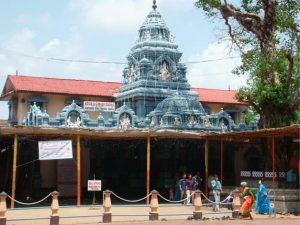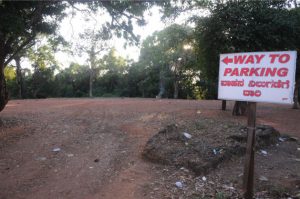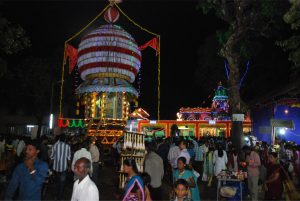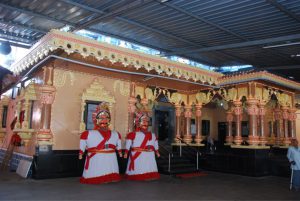ಶ್ರೀ ಕ್ಷೇತ್ರದ ಬಗ್ಗೆ

ಉಡುಪಿ ಜಿಲ್ಲೆಯ ಕುಂದಾಪುರ ತಾಲೂಕಿನ ರಾಷ್ಟ್ರೀಯ ಹೆದ್ದಾರಿ 66 ರಲ್ಲಿ ಉಡುಪಿ – ಕುಂದಾಪುರದ ನಡುವೆ ಹೆದ್ದಾರಿಯಿಂದ ಒಂದು ಕಿ.ಮೀ. ಪೂರ್ವಕ್ಕೆ ಕುಂಭಾಸಿ ಕ್ಷೇತ್ರದಲ್ಲಿ ಆನೆಗುಡ್ದೆ ಇದೆ.
ಕುಂಭಾಸಿಯು ಸಪ್ತಕ್ಷೇತ್ರಗಳಲ್ಲಿ ಒಂದಾಗಿದ್ದು ಇಲ್ಲಿಯ ಆನೆಗುಡ್ದೆ ಶ್ರೀ ವಿನಾಯಕ ದೇವಸ್ಥಾನವು ಅತೀ ಪುರಾತನವಾಗಿದ್ದು ಇಲ್ಲಿಗೆ ಅಧಿಕ ಸಂಖ್ಯೆಯಲ್ಲಿ ಭಕ್ತಾದಿಗಳು ನಿತ್ಯವೂ ಯಾತ್ರಾರ್ಥಿಗಳಾಗಿ ಬಂದು ಶ್ರೀ ದೇವರ ದರ್ಶನ ಪಡೆದು ಸೇವೆಯನ್ನು ಮಾಡಿಸಿಕೊಂಡು ಇಷ್ಟಾರ್ಥವನ್ನು ಪಡೆದು ಕೃತಾರ್ಥಾರಾಗುತ್ತಾರೆ.
ಪರಶುರಾಮ ಸ್ರಷ್ಟಿಯ ಸಪ್ತಕ್ಷೇತ್ರಗಳಲ್ಲಿ ಕುಂಭಾಸಿಯೂ ಒಂದಾಗಿದೆ. ಇದನ್ನು ಕ್ರತಯುಗದಲ್ಲಿ ಹರಿಹರ ಕ್ಷೇತ್ರವೆಂದೂ, ತ್ರೇತಾಯುಗದಲ್ಲಿ ಮಧುಕಾನನವೆಂದೂ, ದ್ವಾಪರಯುಗದಲ್ಲಿ ಗೌತಮ ಕ್ಷೇತ್ರವೆಂದೂ,ಕಲಿಯುಗದಲ್ಲಿ
ಕುಂಭಾಸಿಯೆಂದು ಕರೆಯುತ್ತಾರೆ. ಈ ಕ್ಷೇತ್ರವು ಅನಾವೃಷ್ಟಿಯಿಂದ ಪೀಡಿತವಾದಾಗ ಗೌತಮ ಮುನಿಗಳು ಇಲ್ಲಿ ನೆಲೆಸಿ ಯಜ್ನ ಯಾಗಾದಿಗಳನ್ನು ನಡೆಸಿದರು. ಹೀಗೆ ಈ ಕ್ಷೇತ್ರವು ಯುಗಾಂತರಗಳಿಂದಲೂ ಪವಿತ್ರವಾದುದು ಎಂದು ಪುರಾಣಗಳು ಸಾರುತ್ತವೆ.
ವರ ಬಲ ಪ್ರಮತ್ತನಾದ ಕುಂಭಾಸುರನಿಂದ ತಪೋನುಷ್ಠಾನ ನಿರತವಾದ ಗೌತಮಮುನಿಗಳ ಯಜ್ಞ ಯಾಗಾದಿಗಳಿಗೆ ಭಂಗ ಬರತೊಡಗಿತು.ವನವಾಸ ನಿರತರಾದ ಪಾಂಡವರ ಆಗಮನವನ್ನು ತಿಳಿದು ಗೌತಮರು ಧರ್ಮಜನಿಗೆ
ಕುಂಭಾಸುರನ ಪೀಡೆಯನ್ನು ಅರುಹಿದಾಗ ಧರ್ಮರಾಜನು ಲೋಕ ಖಂಟಕನಾದ ಕುಂಭಾಸುರನನ್ನು ಸಂಹರಿಸಲು ಭೀಮಸೇನನಿಗೆ ಅಪ್ಪಣೆ ಕೊಟ್ಟನು. ಭೀಮಸೇನನು ಯುದ್ಧ ಸನ್ನದ್ಧನಾದನು. ಭೀಮ,ಕುಂಭಾಸುರರಿಗೆ ಭೀಕರ ಯುದ್ದ ನಡೆಯಿತು . ಯುದ್ಧದಲ್ಲಿ ಕುಂಭಾಸುರನು ಅವಧ್ಯನಾಗಿಯೇ ಉಳಿದನು. ಅವನನ್ನು ಸಂಹರಿಸುವ ಬಗ್ಗೆ ಚಿಂತಿಸುತ್ತ ಭೀಮಸೇನನು ಶಿಬಿರಕ್ಕೆ ಹಿಂತಿರುಗುತ್ತಿರುವಾಗ ” ವಿಘ್ನೇಶ್ವರಾನುಗ್ರಹದಿಂದ ಪಡೆದ ಕತ್ತಿಯಿಂದ ಮಾತ್ರ ವಧ್ಯನು.” ಎಂಬ ಅಶರೀರವಾಣಿಯನ್ನು ಕೇಳಿ ಭೀಮಸೇನನು ವಿಶ್ವಂಭರರೂಪಿ ಪರಮಾತ್ಮನನ್ನು ಧ್ಯಾನಿಸಿ ಆನೆಯ ರೂಪದಿಂದ ಭಗವಂತನು ನೀಡಿದ ಕತ್ತಿಯಿಂದ ಅಸುರನನ್ನು ಸಂಹರಿಸಿದನೆಂದು ಐತಿಹ್ಯ ಉಂಟು. ಇದನ್ನೇ ಶ್ರೀ ವಾದಿರಾಜ ಯತಿವರೇಣ್ಯರು ತೀರ್ಥಪ್ರಬಂಧ ಗ್ರಂಥದಲ್ಲಿ ಭೀಮಸೇನನು ಕುಂಭಾಸುರನಿಗೆ ಕತ್ತಿ (ಅಸಿ) ಯಿಂದ ಸಂಹರಿಸಿದ ಕಾರಣ ಕುಂಭಾಸಿ ಎಂದಾಯಿತೆಂದು ವರ್ಣಿಸಿದ್ದಾರೆ. ಈ ಆನೆಗುಡ್ದೆ (ನಾಗಾಚಲ) ದಲ್ಲಿ ಗಣಪತಿಯು ಆನೆ ರೂಪದಲ್ಲಿ ಭೀಮಸೇನನಿಗೆ ಕತ್ತಿಯನ್ನು ಅನುಗ್ರಹಿಸಿದ ಪ್ರದೇಶದಲ್ಲಿ ಆನೆ ಆಕಾರದಲ್ಲಿ ಗಣಪತಿಯು ಉದ್ಭವಿಸಿದನು. ಸೊಂಡಿಲಿನ ಆಕಾರವಿರುವ ಮುಖ ಭಾಗಕ್ಕೆ ಮಾತ್ರ ನಿತ್ಯ ಪೂಜಾದಿಗಳು, ವಿನಿಯೋಗಾದಿಗಳು ನಡೆಯುತ್ತವೆ. ಉಳಿದ ಭಾಗಗಳು ವಿದ್ಯುಕ್ತವಾಗಿ ಗೋಡೆಯಿಂದ ಆವೃತವಾಗಿವೆ. ಈ ನಾಗಾಚಲದಲ್ಲಿ (ಆನೆಗುಡ್ಡೆ ನಾಗಾಚಲವೆಂದು ಪುರಾಣ ಪ್ರಸಿದ್ಧಿ) ಆನೆಯ ರೂಪದಲ್ಲಿ ಪ್ರತ್ಯಕ್ಷನಾದ ಗಣಪತಿಯು ಭಕ್ತಭೀಷ್ಟಪ್ರದಾಯಕನಾಗಿ ವಿರಾಜಮಾನನಾಗಿರುವನು.
ಸುಮಾರು ಏಳು ತಲೆ ಮಾರಿನ ಹಿಂದೆ ಶಿವಳ್ಳಿ ಬ್ರಾಹ್ಮಣ ಪಂಗಡಕ್ಕೆ ಸೇರಿದ ಉಪಾದ್ಯಾಯರ ಕುಟುಂಬದ
ಮೂಲ ಪುರುಷರಾದ ಶ್ರೀ ವಿಶ್ವೇಶ್ವರ ಉಪಾಧ್ಯಾಯರಿಗೆ ಒಬ್ಬ ಬ್ರಹ್ಮಚಾರಿಯು ಈಗಿರುವ ದೇವಾಲಯದ
ಸಮೀಪದ ಕಾಡಿನಲ್ಲಿ ಬಿಟ್ಟು ಹೋದಂತೆ ಕನಸನ್ನು ಕಂಡು, ತಮಗೆ ಪರಿಚಿತವಾದ ಸ್ಥಳವಾದುದರಿಂದ ಕನಸಿನಲ್ಲಿ ಕಂಡಂತೆ ಈ ಪ್ರದೇಶಕ್ಕೆ ಬಂದು ಸುಮಾರು ಎಂಟು ಅಡಿ ವಿಸ್ತೀರ್ಣವುಳ್ಳ ಒಂದು ಕಪ್ಪು ಕಲ್ಲಿನಲ್ಲಿ ಅಸ್ಪಷ್ಟವಾದ ಆನೆಯ ರೂಪವು ಗೋಚರವಾಗಿ ಕಲ್ಲಿನ ಮೇಲೆ ಅನೇಕ ಕಾಡಿನ ಹೂಗಳು ಚೆಲ್ಲಿರುವುದನ್ನು ಕಂಡು ದೇವತಾ ಸಾನಿಧ್ಯದ ಭಾವನೆಯಿಂದ ಕರಡದ ಹುಲ್ಲಿನಿಂದ ಸಣ್ಣ ಗುಡಿಯನ್ನು ಕಟ್ಟಿ 8 ಕಿಲೋಮೀಟರ್ ದೂರದ ತಮ್ಮ ಮನೆಯಿಂದ ಬಂದು ಸ್ನಾನ ಮಾಡಿ ದೇವರಿಗೆ ಅಭಿಷೇಕ ಮಾಡಿ ಹೋಗುತ್ತಿದ್ದರು. ದಿನ ನಿತ್ಯ ದೂರದಿಂದ ಬಂದು ಹೋಗುವುದನ್ನು ನೋಡಿ 1715 ನೇ ಶಕವರ್ಷ 1793 ನೇ ಇಸವಿಯಲ್ಲಿ ಗ್ರಾಮದ ಪ್ರಮುಖರಾದ ಅಣ್ಣ ಹತ್ವಾರರು ಪುಷ್ಕರಣಿಯ ಸಮೀಪದಲ್ಲಿಯೇ ನೆಲೆಸುವಂತೆ ಭಿನ್ನವಿಸಿ ಮನೆ ನಿಮರ್ಾಣಕ್ಕೆ ಧರ್ಮಸಾಧನವಾಗಿ ಸ್ಥಳ ದಾನ ಮಾಡಿದರು.
ಹೀಗೆ ಉಪಾಧ್ಯಾಯ ಕುಟುಂಬದವರು ಶ್ರಧ್ಧಾಭಕ್ತಿಯಿಂದ ಶ್ರೀ ವಿನಾಯಕನನ್ನು ಅರಾಧಿಸಿ ಶ್ರೀ ದೇವರಲ್ಲಿ ವಿಶೇಷ
ಕಲಾ ಸಾನಿಧ್ಯ ನೆಲೆಸುವಂತೆ ಮಾಡಿದರು.
ಹಾಗೆಯೇ ವಿಶೇಷವಾಗಿ ಶ್ರೀ ವಿನಾಯಕ ದೇವರ ಸಂದರ್ಶನಕ್ಕೆ ಬರತಕ್ಕ ಭಕ್ತಾದಿಗಳ ಸಂಖ್ಯೆ ದಿನದಿಂದ ದಿನಕ್ಕೆ
ಹೆಚ್ಚುತ್ತಾ ದೇವಾಲಯದ ಆರಂಭದಲ್ಲಿದ್ದ ಹುಲ್ಲಿನ ಛಾವಣಿಯನ್ನು ತೆಗೆದು ತಾಮ್ರದ ಹೊದಿಕೆಯ ಗರ್ಭಗೃಹ ಹಾಗು ಮಂಗಳೂರು ಟೈಲ್ಸ್ ನ ಪೌಳಿ ನಿರ್ಮಾಣವಾಯಿತು. ಭಕ್ತಾದಿಗಳ ಸಂಖ್ಯೆ ಹೆಚ್ಚುತ್ತಾ ಇಲ್ಲಿ ಪಂಚಕಜ್ಜಾಯ,
ಹರಿವಾಣ ನೈವೇದ್ಯ ಪಂಚಾಮೃತ, ಕಡುಬಿನ ಸೇವೆ, ರಂಗ ಪೂಜೆ, ಇತ್ಯಾದಿ ಸೇವೆಗಳಿಂದ ಇಷ್ಟಾರ್ಥವನ್ನು
ಪಡೆಯುತ್ತಿದ್ದರು.
ಅಭಿವೃದ್ದಿಗೈದು 1985 ರಿಂದ ವಿಶೇಷವಾಗಿ ಭಕ್ತಾದಿಗಳ ಸಹಕಾರದಿಂದ ಅಭಿವೃದ್ದಿ ಕಂಡ ದೇವಾಲಯದಲ್ಲಿ ನೂತನವಾಗಿ ನಿರ್ಮಾಣಗೊಂಡ ಗರ್ಭಗೃಹದ ಹೊರಭಾಗದ ತಾಮ್ರದ ಮಾಡು, ಪೌಳಿ, ಗೊಪುರ, ಐಷಾರಾಮಿ
ವಸತಿ ಗೃಹ, ಸಾಮಾನ್ಯ ವಸತಿ ಗೃಹ, ಡಾರ್ಮಿಟರಿ, 1 ಸಾವಿರ ಜನಕ್ಕೆ ಅನುಕೂಲವಾಗುವ ಭೋಜನ ಶಾಲೆ ನಿರ್ಮಾಣ ವಾಗಿದೆ, ಹಾಗು ಭಕ್ತರು ಕುಳಿತುಕೊಳ್ಳಲು ಅನುಕೂಲವಾಗಲೆಂದು ವಿಶಾಲವಾದ ವಿಶ್ವೇಶ್ವರ ಯಾಗ ಶಾಲೆ ನಿಮರ್ಿತವಾಗಿದೆ. 1 ಕೀ ಮೀ ದೂರದಿಂದ ತೆರೆದ ಬಾವಿಯಿಂದ ನೀರಿನ ವ್ಯವಸ್ಥೆ ಮಾಡಲಾಗಿದೆ.
ಶ್ರೀ ದೇವರಿಗೆ ಸ್ವರ್ಣಮುಖ, ರಜತ ಮಂಟಪ, ಬೆಳ್ಳಿಯ ತೀರ್ಥ ಮಂಟಪ, ಬೆಳ್ಳಿಯ ರಥ, ಸ್ವರ್ಣ ಹಾರಗಳು, ಸುಮಾರು 14 ಕೆಜಿ ಅಪ್ಪಟ ಚಿನ್ನದ ಪಲ್ಲಕ್ಕಿಯೂ ಕೂಡಾ ಸಮರ್ಪಣೆಯಾಗಿದೆ. ಬ್ರಹ್ಮಕಲಶ ವರ್ಧಂತಿ ಕಾರ್ಯ
ಕ್ರಮದಲ್ಲಿ ಅಭಿಷೇಕಕ್ಕಾಗಿ 108 ರಜತ ಕಲಶಗಳು ಹಾಗೂ ಪ್ರಧಾನ ಕಲಶಾಭಿಷೇಕಕ್ಕಾಗಿ 2 kg ಅಪ್ಪಟ ಚಿನ್ನದಿಂದ ಕುಸುರಿ ಕೆಲಸದಿಂದ ಕೂಡಿದ ಅಷ್ಟ ಲಕ್ಷ್ಮೀ ಕಲಶ ಅರ್ಪಿತವಾಗಿದೆ. ದಿನವೂ ಇಲ್ಲಿಗೆ ಬರತಕ್ಕ ಭಕ್ತಾದಿಗಳಿಗೆ ಮಧ್ಯಾಹ್ನದ ಭೋಜನ ವ್ಯವಸ್ಥೆ ಮಾಡಲಾಗಿದೆ.
ಕರ್ನಾಟಕ ರಾಜ್ಯದ ಉಡುಪಿ ಜಿಲ್ಲೆಯ ಕುಂದಾಪುರ ತಾಲೂಕಿನ ಕುಂಭಾಸಿ ಗ್ರಾಮದಲ್ಲಿರುವ 444ನೇ ಆನೆಗುಡ್ಡೆ ಶ್ರೀ ವಿನಾಯಕ ದೇವಸ್ಥಾನದ ಮೊಕ್ತೇಸರಿಕೆ ಹಾಗು ಅರ್ಚಕತನವು ಶಿಲೆ ಶಿಲೆಯಾಗಿ ಶಿವಳ್ಳಿ ಬ್ರಾಹ್ಮಣ ಪಂಗಡದ
ಉಪಾಧ್ಯಾಯರ ಕುಟುಂಬದ ವಾರೀಸು ಹಕ್ಕಿನದ್ದಾಗಿರುತ್ತದೆ. ಈ ದೇವಾಲಯದ ಆಡಳಿತವು ಮೂರು ಶಾಖೆಗಳಲ್ಲಿ ಅನುವಂಶಿಯಕವಾಗಿ ನಡೆದುಕೊಂಡು ಬರುತ್ತಿದ್ದು ಅರ್ಚಕ ತನವು ಕುಟುಂಬದ ನಾಲ್ಕು ಶಾಖೆಗಳಿಂದ ನಡೆದು ಕೊಂಡು ಬರುತ್ತಿದೆ. ಪ್ರಕೃತ ಶ್ರೀ ಕೆ ಶ್ರೀರಮಣ ಉಪಾಧ್ಯಾಯರು ಆಡಳಿತ ಧರ್ಮಧರ್ಶಿಯಾಗಿ
ಶ್ರೀ ಕೆ ವಿಠಲ ಉಪಾಧ್ಯಾಯರು, ಹಾಗೂ ಶ್ರೀ ಕೆ ನಿರಂಜನ ಉಪಾಧ್ಯಾಯರು ಮೊಕ್ತೇಸರಾಗಿ ಸೇವೆ ಸಲ್ಲಿಸುತ್ತದ್ದ ವಿಶ್ವಂಭರ ಉಪಾಧ್ಯಾಯರು ನಿಧನರಾದುದರಿಂದ, ದಿವಂಗತ ಕೆ ಕೃಷ್ಣಮೂರ್ತಿ ಉಪಧ್ಯಾಯರ ಉತ್ತರಾಧಿಕಾರಿಯಾಗಿ ಅವರ ಪುತ್ರ ಶ್ರೀರಮಣ ಉಪಾಧ್ಯಾಯರು ಧರ್ಮಧರ್ಶಿಯಾಗಿ ಅಧಿಕಾರ ಸ್ವೀಕರಿಸಿ ಸೇವೆ ಸಲ್ಲಿಸುತ್ತಿದ್ದಾರೆ.
ಆಯುಕ್ತರು LAW/AP50/63-64 ದಿನಾಂಕ 07-07-1964 ರಲ್ಲಿ ಈ ದೇವಾಲಯದ ಮೋಕ್ತೇಸರಿಕೆ ಅನುವಂಶಿ ವೆಂದು ಘೋಷಿಸಿದ್ದಾರೆ. ಹಾಗೆಯೇ RA NO 4/2007 ದಿನಾಂಕ 23-10-2009 ರಂದು ಉಡುಪಿ ಜಿಲ್ಲಾ ತ್ವರಿತ ವಿಲೇವಾರಿ ನ್ಯಾಯಲಯವು ಆನೆಗುಡ್ಡೆ ಶ್ರೀ ವಿನಾಯಕ ದೇವಾಲಯವನ್ನು ಶಿವಳ್ಳಿ ಬ್ರಾಹ್ಮಣ ಉಪ ಪಂಗಡಕ್ಕೆ ಸೇರಿದ ದೇವಾಲಯವೇಂದು ಷೋಷಣೆ ಮಾಡಿದೆ. ಕರ್ನಾಟಕ ಉಚ್ಚ ನ್ಯಾಯಲಯ NO RSA 966/2011 ದಿನಾಂಕ 09-07-2012 ರಂದು ಸರಕಾರದ ಮೇಲ್ಮನವಿ ಅರ್ಜಿಯನ್ನು ಹಿಂದಕ್ಕೆ ಪಡೆದ ನೆಲೆಯಲ್ಲಿ ಮೇಲ್ಮನವಿಯನ್ನು ವಜಾ ಗೊಳಿಸಿದೆ.
ದೇವಾಲಯದಲ್ಲಿ ಬೆಳಿಗ್ಗೆ 6.00 ಗಂಟೆಗೆ ಮಧ್ಯಾಹ್ನ 1 ಗಂಟೆಗೆ ರಾತ್ರಿ 8.30 ಕ್ಕೆ ತ್ರಿಕಾಲದಲ್ಲಿ ಪೂಜೆ ನೆಡೆಯುತ್ತದೆ.
ಬೆಳಿಗ್ಗೆ 6.00 ಗಂಟೆಯಿಂದ ರಾತ್ರಿ 9.00 ರ ತನಕ ಅವಿರತವಾಗಿ ಭಕ್ತಾದಿಗಳಿಗೆ ದೇವರ ದರ್ಶನಕ್ಕೆ ದೇವಾಲಯ
ಮುಕ್ತವಾಗಿರುತ್ತದೆ. ವಾರದಲ್ಲಿ ಭಾನುವಾರ, ಮಂಗಳವಾರ, ಶುಕ್ರವಾರ ಹಾಗೂ ಸಂಕ್ರಮಣ, ಸಂಕಷ್ಟಹರ ಚಥುರ್ಥಿ ದಿನಗಳಲ್ಲಿ ಅಧಿಕ ಸಂಖ್ಯೆಯಲ್ಲಿ ಭಕ್ತರು ದೇವರ ಸಂದರ್ಶನಕ್ಕೆ ಬರುತ್ತಾರೆ.
ಪ್ರತಿ ಸಂಕಷ್ಟಹರ ಚಥುರ್ಥಿ ದೇವಾಲಯದ ವತಿಯಿಂದ ಅಷ್ಟೋತ್ತರ ಸಹಸ್ರನಾಳಿಕೇರ ಗಣಯಾಗ
ನೆಡೆಯುತ್ತದೆ. ರಾತ್ರಿ ಕಾಲ ತಂಗಲು ಐಷಾರಾಮಿ ಹಾಗು ಸಾಮಾನ್ಯ ಅತಿಥಿಗೃಹಗಳ ಸೌಲಭ್ಯವಿದೆ.
ಆನೆಗುಡ್ಡೆ ದಕ್ಷಿಣ ಭಾರತದಲ್ಲೇ ಪ್ರಸಿದ್ದಿಯಾಗಿದ್ದು ದೇಶದ ಎಲ್ಲಾ ಭಾಗಗಳಿಂದ ಭಕ್ತರು ಆಗಮಿಸುತ್ತಿದ್ದು,
ಶ್ರೀ ದೇವರ ಅನುಗ್ರಹಕ್ಕೆ ಪಾತ್ರರಾಗುತ್ತಾರೆ
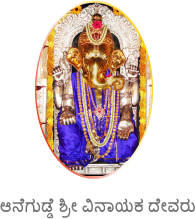
Mythology tells us that the great sage Gouthama had his hermitage at Kumbhasi and several sages, including Agastya, did tapas here. The Ganapathi Temple on top of the hill and the Temple of Mahalingeshwara at the foot – at the place where Sage Gouthama’s ashram stood once – are intimately connected. Legend has it that Parvathi wanted Ganapathi to find a holy place where Ganga, held in Shiva’s matted hair, could descend to bless people. Disguised as a young novice, Ganapathi came to Gouthama’s ashram with a cow. When the cow died in his ashram, Gouthama prayed to Lord Shiva, asked him to pour the sacred water of Ganga from his locks, held it in his kamandala, sprinkled it on the cow and brought it back to life. That served Ganapathi’s, and Parvathi’s, purpose. The small kumbha-shaped well in the sanctum sanctorum of the Mahalingeshwara Temple was created from Gouthama’s kamandala and its water is blessed by the presence of Mother Ganga. Nearby, in the parikrama of the temple, there is another little well. It is the pure and sacred water of this well that is taken up every day to Anegudde for the abhisheka of Lord Ganapathi..
In Dwapara, a powerful Rakshasa named Kumbha, strengthened by boons he obtained from Lord Shiva through rigorous penance, troubled the sages of Gouthama’s hermitage. When the Pandavas were passing this way on a pilgrimage, Sage Gouthama appealed to Yudhistira to come to the aid of the inmates of the Ashram. Yudhistira asked his brother Bhima, who was ever ready to fight with the Rakshasas, to destroy Kumbha and his army.
But Kumbha, strengthened as he was by divine boons, proved a match even for Bhima. After a daylong battle with the Rakshasa proved inconclusive, Bhima heard a voice from the Heavens announce that Kumbha could be destroyed only with an asi or sword obtained from Lord Ganapathi. So Bhima worshipped Ganapathi, who appeared before him in the form of an elephant and gave him a mighty sword. With that sword or asi Bhima decapitated Kumbha and destroyed his demon army. The place where Bhima killed Kumbha with an asi came to be known as Kumbhasi. And the hill where Lord Ganapathi appeared before him, earlier called Nagachala, became known as Elephant Hill – ‘Gajagiri’ in Sanskrit and ‘Anegudde’ in Kannada
The image of Lord Ganapathi worshipped here is a large stone untouched by hammer and chisel. The silver image we see every day and the gold face the Lord dons on special occasions are mukhawadas. The original image – the Moola Bimba – is ‘niraakaara’; it seems to have no lineaments carved on it, either by Nature or human hand, though many people think that a faint trace of an elephant’s trunk is discernible. We can see this Moola Bimba twice during the day – once at dawn when the Nirmaalya Pooja is performed, and again at Noon when the Abhisheka is performed before the Maha Pooja. Watching the abhisheka of the Moola Bimba is a wonderful spiritual experience. Devotees watch the Moola Bimba with bated breath during this ritual. They become all eyes, and look for the Lord, seek some lineament that might suggest the features of the Elephant headed God. Their keenness and anxiety have to be seen to be believed. Without realizing it, these devotees have taken their first step towards salvation. They have become seekers.
At Anegudde the long train of abhishekhas, archanas and poojas begins at dawn, and continues till the final Mangalaarathi is performed at night, around 9 P.M. The day begins with the chanting of ‘Suprabhaatha’, and then comes the Nirmaalya pooja. The flowers with which the Lord was decorated the previous night are removed, and the silver covering is taken off. The Moola Bimba is given an abhisheka of pure water brought from the well below. The abhisheka is performed with mantras from Ganapathi Atharvasheersha. Then the silver covering is replaced, but with one important difference. The head remains unchanged, but the silver covering used for the body is a different one this time. The Lord is not sitting now. He is standing, ready to receive the innumerable poojas, sevas, and archanas his devotees offer to him.
The morning pooja is next performed. This long morning ritual takes place at dawn all through the year, except in the month of Karthika, when it is performed an hour earlier, at the time the birds wake up. It is called Pakshi Jaagara Pooja.
The Lord who took the standing posture after the Abhisheka in the morning, keeps standing till eleven or half past eleven, when the Abhisheka that precedes the Maha Pooja begins. This Abhisheka, with kalasha, is done twenty-one times, with Upanishat mantras. This is followed by Panchamrita Abhisheka. The Bimba is washed again with shuddha kalasha, with the same sacred water from Gouthama Theertha. The full Abhisheka takes more than half an hour.
Then the Bimba is decorated with a few flowers. Those who watch this carefully can see that a pattern emerges from the way the flowers are arranged – the sacred word, ‘OM’. Ganapathi is worshipped at Anegudde as Om-kaara Moorthi, or Pranava Swaroopa. You must perceive him with your ears as well as your eyes.
When the silver covering is replaced, and the image recreated after the Abhisheka, you will find the seated figure of Ganapathi. He will keep on sitting for the rest of the day and for the whole night, till he decides to stand up again the next morning – after his morning Abhisheka.
One of the most important sevas devotees can offer here is Gana homa. These homas are performed every day except on ekaadashi, ranging from that of one coconut to 1008 coconuts. ‘Upanishat Homa’, based on Ganapathi Athrvasheersha Upanishat, is another rare homa that can be performed here. These homas and yajnas are performed in a Yajna Mantapa so well designed that even during the biggest yajnas and yaagas the devotees who throng the mantapa and the priests who sit round the yajna kunda are not troubled by heat and smoke. The Gana homas, which begin at Ten, get over around the time the Abhisheka gets over. Then the image worshipped in the Yajana Mantapa is brought in to the sanctum sanctorum and placed before the main image. Now the Maha Pooja begins.
Apart from Gana homas, the devotees can offer to the Lord a variety of Sevas, from simple aarathis and archanas to Satya Ganapathi Vritha, Ranga Pooja, Maha Pooja and so on. The Lord of Anegudde is very fond kotte kadabu, an iddli like delicacy cooked in leaves of Mundaka. So people offer him kadabus, made from one seru to twelve mudis – about 400 kilos! – of rice. Moodu Ganapathi is another unusual seva that can be offered here. Devotees bring 125 or 1,108 coconuts, the broken halves of which are arranged in a heap before the Lord and then decorated with fruits and flowers. Devotees feel that Ganapathi rises in these decorated heaps of coconuts, and that is why the seva is called Moodu Ganapathi – or ‘Rising Ganapathi.’
Though Bhima worshipped Ganapathi at Nagachala, it is not clear whether he worshipped any image of the Lord. But most devotees believe that the bimba they worship now at Anegudde is the one that Bhima worshipped earlier, and before him Agastya and others. This Moola Bimba was discovered about a hundred and fifty years ago. The temple was built some years later.
At Korgi, a small village five miles east of Kumbhasi, lived a devout Brahmin named Vishveshwara Upadhya. He used to visit Kumbhasi regularly to have a dip in the sacred Pushkarani surrounding the temple and have a darshana of Lord Mahalingeshwara. In his dream one night he saw a young novice who told him he was hungry, and then led him towards Kumbhasi. At Anegudde the boy suddenly disappeared near a large stone. Vishveshwara Upadhya was deeply moved by the dream. Next morning he followed the path he had taken in his dream and soon arrived at the spot where the boy had disappeared, and saw that stone again. He had seen it on innumerable occasions on his way to Kumbhasi, but on that day he felt that he saw in that stone the features of Lord Ganapathi. He was thrilled. There were flowering trees like Bakul near the stone, and he saw that their flowers had fallen, on their own, on the image. He was so impressed by what he saw that on his way back from Kumbhasi he brought some water from the sacred well of Gouthama Teertha and poured it on the image, and worshipped it with wild flowers and fruits he gathered from the surrounding bushes and trees.
Whatever doubts this devout Brahmin might have had about the presence of divinity in that Stone disappeared, they say, when he saw, a few days later, a cow standing near the Stone, milk from its udder pouring on it. He now became an ardent devotee of Lord Ganapathi, and worshipping that image with proper rituals became his life’s mission. People, impressed by his devotion, gave him a place to stay at Kumbhasi, so that he need not come all the way from Korgi every day to do his pooja. He built for himself a house there, but only after he built a little temple of thatched roof for the God he worshipped at Anegudde.
That temple, which remained an obscure one for several decades, is the Ganapathi temple of Anegudde, which thousands visit every day now, and hundreds of thousands on special occasions. Vishveshwara Upadhya passed away long before the temple he built became one of the best loved temples of our District. But his descendents, who are now the hereditary archakas of the temple, worship Lord Ganesha with the same devotion and fervour as their ancestor did.
There are Guest Houses for people who come from distant places, and free food is provided to people at noon, after the Maha Pooja. The temple and its surroundings are kept clean. The place is open, green and breezy.
The temple is easily accessible. The place is between Kundapura and Udupi on N.H.66, five km from Kundapura and 26 km from Udupi. A big arch indicates where you have to turn east, and you can get down from your bus there and walk up to the temple, or drive right up to the temple door. You can offer your simple sevas like aarathis and archanas, and your pradakshina namaskaaras, at any time of the day. If you want to perform Gana Homa you should reach the temple by 11, and then be prepared to wait for an hour or so, till the homa gets over, for the prasaada. Early intimation is necessary for the bigger Sevas.
The old traditional way of going to the Temple is a little more arduous, but much more interesting. You get down from your bus at the Kumbhasi Bus Stop which is about 150 yards north of the Arch. A straight road takes you to the Mahalingeshwara (also known as Harihareshwara) Temple and Gouthama Teertha, which are only a furlong away. At the North East corner of this Temple you find steep steps going up to Anegudde. If you are old you might find the climb tough, but those who live at Kumbhasi, mostly descendents of Vishveshwara Upadhya, ascend these steps at least once a day, as long as they are on their feet, even when they are past seventy. After climbing these steps you reach a Mantapa where you can sit and get your wind back. From the Mantapa you can see in the north the Kutachadri Hills of the Sahyadri Range, and in the west, the Arabian sea; and in the east, sitting pretty behind an ancient Ashwattha tree, just a minute’s walk away, the Maha Ganapathi Temple of Anegudde.
